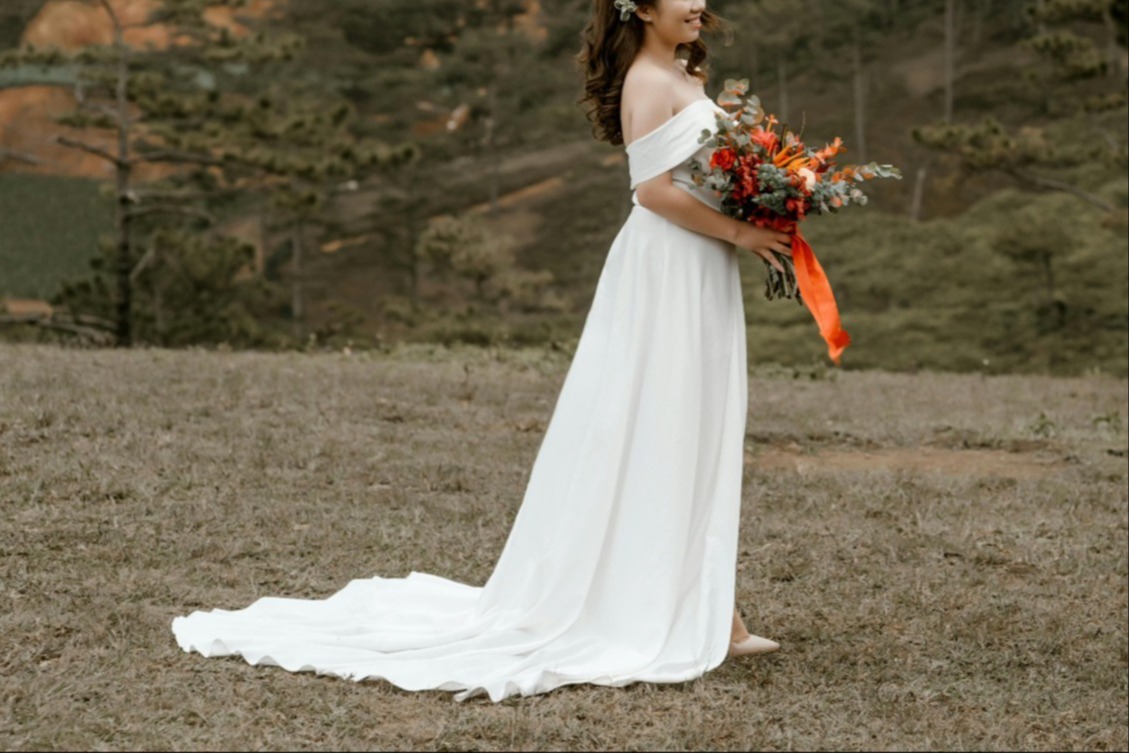- trains
- watteau
- monarch / royal
- cathedral
- semi-cathedral
- chapel
- court
- sweep / brush
- skirts
- floor length
- full length / maxi
- high-low
- tea length
- midi
- knee length
- mini
The length of your dress can drastically impact how formal it feels, and the practicality of it.
You need to consider the size of your aisle and overall venue, if you've got people who can help you carry a train, what sort of surfaces you'll be walking on, and your own comfort and sense of style when choosing how long you want your dress to be.
trains
A train is the part of a dress that extends beyond the hemline of the skirt, on to the floor. It's a stylistic choice that adds a sense of grandeur and formality to a dress, with the extra fabric trailing behind the bride as she walks down the aisle enhancing the visual impact. They're also just a lot of fun!
The measurements for each category seem to vary a little between individual articles, salons and seamstresses, and between American sources and Australian sources. So, while I've strived to make them as accurate as possible, these measurements are just a guide.
watteau
any length
Watteau trains differ from all of the others as they fall from the shoulders or the upper back of the bodice, rather than being a direct extension of the skirt. They can be any length.
Their chic, cape-like effect makes watteaus a sort of middle-ground between a veil and a train, which means they're very popular with modern brides who choose to forgo a veil. They're often removable, which means that they're a practical choice as well as a stylish one.
monarch / royal
250cm +
Monarch trains are the longest and most dramatic type of train. There's not really a limit to how long they can be, but anything that extends over 2.5 metres beyond the hemline qualifies. 3 metres to 3.5 metres is the most popular length in this category.
You need an extremely spacious venue and extremely helpful bridesmaids to accommodate a skirt of this length, but they certainly make a dramatic statement.
cathedral
180cm - 240cm
Cathedral trains extend between 1.8 metres and 2.4 metres from the hemline.
They're usually designed with grand indoor venues like cathedrals, ballrooms and estates in mind, where you can make a dramatic walk down a long, wide aisle with the train following behind you. You need very helpful bridesmaids to aid you in keeping this voluminous skirt neat, but they're a very popular option for brides looking for a dramatic or fairytale feeling.
semi-cathedral
130cm - 170cm
Semi-cathedral trains fall between 1.3 metres and 1.7 metres long, measured from the hemline.
This in-between length means that they still make a dramatic statement, but are slightly lighter and easier to manage than a full cathedral train.
chapel
90cm - 120cm
Chapel trains are between 90 centimetres and 1.2 metres long when measured from the hemline.
They're a timeless option, and are the most popular train length for modern brides, as they provide a good balance of dramatic visuals and practical wearability. You still get the formal, sweeping, statement bridal look, but this length makes them more comfortable to wear and easier to manage than the longer options.
court
30cm - 60cm
Court trains only extend 30 centimetres 60 centimetres beyond the hemline.
Modest and sophisticated, they're a great practical choice, as this length means that you still get the formality and sense of tradition that they afford a gown, but can avoid the weight and hassle of a longer one.
sweep / brush
15cm - 25cm
Sweep / brush trains are the shortest type of train, measuring less than 25 centimetres from the hemline. They typically extend only 15 centimetres to 20 centimetres beyond the hem of the gown.
Subtle but still elegant, having a train that just brushes or sweeps the floor means that you still get a lovely swooshing effect and a little flair, but in a much more practical way. This train length is particularly popular for outdoor weddings.
skirts
If you decide that you don't want a train, there are still plenty of different options for the length of your dress.
floor length
Floor length dresses, as the name suggests, fall exactly to the floor.
There's no pooling fabric to create a train, just a hemline that covers your feet and stops right on the floor. They can be pretty much any silhouette in any fabric, from sleek and slinky sheath dresses to voluminous A-lines.
full length / maxi
Full length or maxi dresses should either come down to your ankles or just brush the top of your shoes.
They're a fun way to show off your wedding shoes while still providing some of the formality that comes from wearing a long dress. The practicality of their length and the flowy, billowy material that they tend to be made of means they're perfect for outdoor weddings.
high-low
High-low dresses, as the name suggests, feature skirts that are cut higher at the front and fall to floor in the back.
You can increase the drama by having the front cut to above the knees and the back billowing in a long, dramatic train, or you can simply have the front cut just high enough to show off your shoes.
tea length
Tea-length dresses have fitted bodices and skirts that fall from the natural waist to just above the ankle.
They usually have the silhouette of a short ballgown, and are perfect for vintage-style weddings. They're also popular for weddings that are a bit more casual, such as courthouse ceremonies.
midi
Midi dresses have hemlines that fall to mid-calf.
They can be form-fitting or loose and flowy, depending on the cut of the skirt and the fabric. They're always a charming choice, popular for more casual weddings and courthouse ceremonies, but can be styled in a more formal way depending on how you accessorise it.
knee-length
As the name suggests, knee-length dresses have hemlines that fall right to the knee.
They usually have a fitted bodice and a skirt that flares out from the natural waist. They're a fun option that can lean either vintage or minimal, depending on the rest of the styling, and are popular for elopements and destination weddings.
mini
Mini dresses have hemlines that fall above the knee.
They can be fitted or flowy, depending on the cut of the skirt and the fabric, but they're a always a bold choice, popular for more casual weddings, elopements and courthouse ceremonies. Many modern brides choose a more traditional style dress for their ceremony and photos before changing into a mini dress for their reception.







